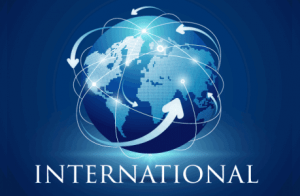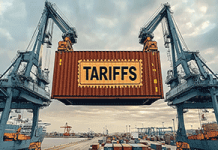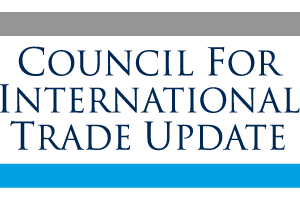 After a flurry of activity over the weekend and into yesterday, President Donald Trump put on hold for 30 days the 25% tariffs on Canada and Mexico (except a 10% tariff for Canadian oil). His 10% tariffs on China went into effect at 12:01 a.m. today.
After a flurry of activity over the weekend and into yesterday, President Donald Trump put on hold for 30 days the 25% tariffs on Canada and Mexico (except a 10% tariff for Canadian oil). His 10% tariffs on China went into effect at 12:01 a.m. today.
On Monday morning, February 3, President Trump confirmed he had reached an agreement with Mexico President Sheinbaum to delay tariffs until March 1 following her willingness to send 10,000 troops to the U.S.-Mexico border.
In the same afternoon, President Trump reached a similar agreement with Canada, which promised to send new helicopters, technology and personnel to the border in return for a 30-day hold on tariffs.
“The California Chamber of Commerce is committed to supporting a free trade agenda that fosters economic growth and job creation,” said CalChamber President and CEO Jennifer Barrera. “We strongly oppose protectionist measures, including tariffs, which disrupt global supply chains, raise consumer prices, and hinder the competitiveness of California businesses. A focus on trade agreements instead will ultimately lower both tariff and non-tariff barriers and help create long-term, sustainable economic growth.”
From the White House
The White House released a fact sheet on February 1, stating the executive orders for the tariffs were due to the “extraordinary threat posed by illegal aliens and drugs, including deadly fentanyl,” constituting “a national emergency under the International Emergency Economic Powers Act (IEEPA).”
Tariffs can be country specific, product specific, or universal / global citing a national economic emergency to provide legal justification for implementing them under the International Economic Emergency Powers Act of 1977 — although this has never been used. Historically IEEPA has been used for foreign sanctions.
The Executive Orders below follow on President Trump’s America First Trade Policy released on January 20 directed to nine government entities. It states: “Americans benefit from and deserve an America First trade policy. Therefore, I am establishing a robust and reinvigorated trade policy that promotes investment and productivity, enhances our Nation’s industrial and technological advantages, defends our economic and national security, and — above all — benefits American workers, manufacturers, farmers, ranchers, entrepreneurs, and businesses.”
Imposing Duties to Address the Flow of Illicit Drugs Across Our Northern Border – The White House February 1, 2025
Imposing Duties to Address the Situation at Our Southern Border – The White House February 1, 2025
Imposing Duties to Address the Synthetic Opioid Supply Chain in the People’s Republic of China – The White House February 1, 2025
Mexico, Canada and China are the top three trading partners for both the United States and California.
Mexico
Mexico continues to be California’s top export market. California exports totaled $33.26 billion in 2023. Exports increased by 8.03% compared to 2022. Mexico purchases 18.6% of all California exports. California’s exports to Mexico are driven by computers and electronic products, which account for 17.5% of all California exports to Mexico. Other top categories included transportation equipment, chemicals and non-electrical machinery.
Mexico is California’s second largest import partner, with total imports in 2023 being $61.5 billion. Top products include: transportation equipment at $14.7 billion; computer and electronic products at $13.48 billion; agricultural products at $7.04 billion; and electrical equipment and appliances at $5.07 billion.
Canada
Canada is California’s second largest export market, purchasing 10.7% of all California exports. In 2023, California exported more than $19.07 billion to Canada. Exports to Canada decreased by 7.35% in 2023 compared to 2022. Computers and electronic products remained California’s largest exports, accounting for 26.4% of all California exports to Canada.
California imported more than $15.6 billion from Canada in 2023, ranking it seventh among California import partners. Top products imported from Canada in 2023 included: processed foods at almost $3.6 billion; transportation equipment at $2.6 billion; chemicals at $1.12 billion; and oil and gas at almost $1.1 billion.
China
California exports to China totaled $16.87 billion in 2023, a 7.05% decrease from the year before. Computers and electronic products were the largest export to China, accounting for 22% of exports.
China is California’s top import partner with California demand for Chinese goods totaling $120.5 billion in 2023. The top products imported from China to California included: computer and electronic products, totaling almost $40.1 billion; electronic equipment and appliances at $18.8 billion; miscellaneous manufactures at $14.3 billion; and apparel accessories at almost $7.2 billion.
CalChamber Position
The CalChamber supports free trade worldwide, expansion of international trade and investment, fair and equitable market access for California products abroad, and elimination of disincentives that impede the international competitiveness of California business.
The CalChamber will continue to focus on lowering tariff and non-tariff barriers to support the expansion of American exports. While strategic use of tariffs or the threat of tariffs may be a meaningful negotiation tool, the CalChamber supports efforts to reduce taxation and regulatory burden as a means to create jobs and economic growth.
The CalChamber seeks commercially meaningful outcomes in negotiations with regions around the world and supports bilateral, regional and multilateral trade agreements which are critical to consumers, workers, businesses, farmers and ranchers, and would allow the United States to compete with other countries that are negotiating agreements with each other.
The Biden administration was not proactive in any form of trade agreements. It is hoped that the Trump administration will focus on the promotion of trade agreements versus a heavy tariff policy. During the first Trump administration, negotiations were started with both the United Kingdom and Kenya to establish free trade agreements.
What the Trump administration trade policy will do is to highlight the importance of promoting subnational diplomacy, as it builds more layers and durability into the fabric of U.S. international partnerships and adds to the country’s global diplomacy by building lasting relationships among leaders at many levels.
The CalChamber assures our international trade and investment partners that California continues to value international trade and investment.


